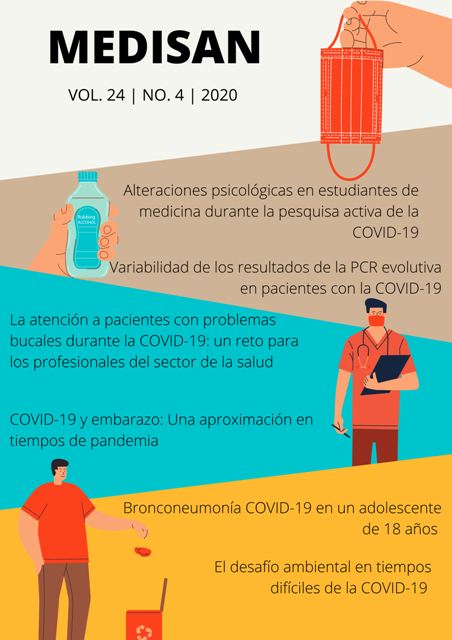The environmental challenge: teachings with COVID-19 as a starting point
Keywords:
environment, environmental risks, SARS-CoV-2 virus, COVID-19.Abstract
The environmental questions are linked to the emergency of epidemics. The crisis that world faces today has had its origin in the constant environmental interferences, what has been reflected in the concerns manifested by the United Nations Organization in each celebration of the Environment World Day. The degraded ecosystems cannot offer ecological services that guarantee well-being and health; this way, a crisis takes to another. In this work it is exposed how men are exposed to more than a million of unknown pathogens microorganisms that could cross the barrier of the species when breaking the natural balance that protects him of multiple risks, such is the case of the SARS-CoV-2 new virus; this comes on top of the threat of the climatic change that is an instigator of many risks. Health problems will always be subject to the interaction of each civilization with their environment, what depends, in essence, of the character in man-nature relationship.
Downloads
References
2. Ramonet I. Ante lo desconocido: La pandemia y el sistema mundo. Cubadebate. 25 Abr 2020 [citado 23/05/2020]. Disponible en: http://www.cubadebate.cu/especiales/2020/04/25/especial-de-ignacio-ramonet-ante-lo-desconocido-la-pandemia-y-el-sistema-mundo/
3. CEPAL. El desafío social en tiempos del COVID-19. Informe especial No. 3. Santiago de Chile: ECLAC; 2020 [citado 23/05/2020]. Disponible en: https://repositorio.cepal.org/bitstream/handle/11362/45527/5/S2000325_es.pdf
4. Moreno-Sánchez F, Coss Rovirosa MF, Alonso de León MT, Elizondo Ochoa A. Las grandes epidemias que cambiaron al mundo. An Méd (Mex). 2018;63(2):151-6.
5. Coelho MTP, Rodrigues JFM, Medina AM, Scalco P, Terribile LC, Vilela B, et al. Exponential phase of covid19 expansion is not driven by airport connetions. medRxiv. 2020 May [citado 03/06/2020]. Disponible en: https://covid-19.conacyt.mx/jspui/bitstream/1000/77/1/exponential%20phase.pdf
6. Qu G, Li X, Hu L, Jiang G. An imperative need for research on the role of environmental factors in transmission of novel coronavirus (COVID-19). Sci. Technol. 2020; 54: 3730-32.
7. López Ricalde CD, López-Hernández ES, Ancona Peniche I. Desarrollo sustentable o sostenible: una definición conceptual. Horizonte Sanitario. 2005 [citado 23/05/2020];4(2). Disponible en: https://www.redalyc.org/pdf/4578/457845044002.pdf
8. Rivera-Hernández JE, Blanco-Orozco NV, Alcántara-Salinas G, Pascal Houbron E, Pérez-Sato JA. ¿Desarrollo sostenible o sustentable? La controversia de un concepto. Revista Posgrado y Sociedad. 2017;15(1):57-67.
9. Leff E, Argueta A, Boege E, Porto-Gonçalves CW. Más allá del desarrollo sostenible. La construcción de una racionalidad ambiental para la sustentabilidad: una visión desde América Latina. Medio Ambiente y Urbanización. 2003; 29(1):65-108.
10. Sáenz Calero CA. Microplásticos en la biota de los ríos andinos [tesis de grado]. Quito: Universidad de las Américas; 2020 [citado 23/05/2020]. Disponible en: http://dspace.udla.edu.ec/bitstream/33000/12051/1/UDLA-EC-TIAM-2020-04.pdf
11. Walsh CJ, Roy AH, Feminella JW, Cottingham PD, Groffman PM, Morgan RP. The urban stream syndrome: current knowledge and the search for a cure. Journal of the North American Benthological Society. 2005;24(3):706-23.
12. Wu Z, McGoogan JM. Characteristics of and important lessons from the coronavirus disease 2019 (COVID-19) outbreak in China: summary of a report of 72 314 cases from the Chinese Center for Disease Control and Prevention. JAMA. 2020;323(13):1239-42.
13. Zhou P, Yang XL, Wang XG, Hu B, Zhang L, Zhang W, et al. A pneumonia outbreak associated with a new coronavirus of probable bat origin. Nature. 2020;579(7798):270-3.
14. Abereu MRP, Tejeda JJG, Guach RAD. Características clínico-epidemiológicas de la COVID-19. Revista Habanera de Ciencias Médicas. 2020 [citado 23/05/2020];19(2):3254. Disponible en: http://www.revhabanera.sld.cu/index.php/rhab/article/view/3254/2505
15. WildforLife. El día mundial del pangolín. Washington, D.C.: ONU; 2017 [citado 23/05/2020]. Disponible en: https://wildfor.life/es/world-pangolin-day
16. Salazar M. Los Pangolines en Peligro: se necesita el apoyo mundial para frenar el comercio global chino [citado 23/05/2020]. Disponible en: https://es.mongabay.com/2015/12/los-pangolines-en-peligro-se-necesita-el-apoyo-mundial-para-frenar-el-comercio-global-chino/
17. Medellín RA, Víquez-R L. Los murciélagos como bioindicadores de la perturbación ambiental. En: Vertebrados terrestres. Ciudad de México: INECC; 2014. p. 521-42.
18. Global Network of Civil Society Organizations for Disasters Reduction. Strategy 2020-2025: Local leadership for global impact. Teddington: GNDR; 2020.
19. Casanova L, Rutala WA, Weber DJ, Sobsey MD. Survival of surrogate coronaviruses in water. Water Res. 2009;43(7):1893-8.
20. Hindson J. COVID-19: faecal–oral transmission? Gastroenterology & Hepatology. 2020;17(5):259.
21. Yu Y, Li Y, Wong TW, Tam W, Chan AT, Lee J, et al. Evidence of airborne transmission of the severe acute respiratory syndrome virus. N Engl J Med. 2004;350(17):1731-9.
22. Wang J, Tang K, Feng K, Weifeng L, Chen K, Wang F. High temperature and high humidity reduce the transmission of COVID-19. SSRN Electronic Journal. 2020 Mar [citado 03/06/2020]. Disponible en: http://dx.doi.org/10.2139/ssrn.3551767
23. Ma Y, Zhao Y, Liu J, He X, Wang B, Fu S, et al. Effects of temperature variation and humidity on the death of COVID-19 in Wuhan, China. Science of the Total Enviroment. 2020;724:138226.
24. Sajadi MM, Habibzadeh P, Vintzileos A, Shokouhi S, Miralles-Wilhelm F, Amoroso A. Temperature and latitude analysis to predict potential spread and seasonality for COVID-19. SSRN Electronic Journal. 2020 Mar [citado 03/06/2020]. Disponible en: http://dx.doi.org/10.2139/ssrn.3550308
25. Alipio M. Do latitude and ozone concentration predict Covid-2019 cases in 34 countries? SSRN Electronic Journal. 2020 Abr [citado 03/06/2020]. Disponible en: http://dx.doi.org/10.2139/ssrn.3572114
26. Frontera A, Martin C, Vlachos K, Sgubin G. Regional air pollution persistence links to covid19 infection zoning. Journal of Infection. 2020 [citado 03/06/2020];2:38. Disponible en: https://www.ncbi.nlm.nih.gov/pmc/articles/PMC7151372/pdf/main.pdf
Published
How to Cite
Issue
Section
License
All the articles can be downloaded or read for free. The journal does not charge any amount of money to the authors for the reception, edition or the publication of the articles, making the whole process completely free. Medisan has no embargo period and it is published under the license of Creative Commons, International Non Commercial Recognition 4.0, which authorizes the copy, reproduction and the total or partial distribution of the articles in any format or platform, with the conditions of citing the source of information and not to be used for profitable purposes.





